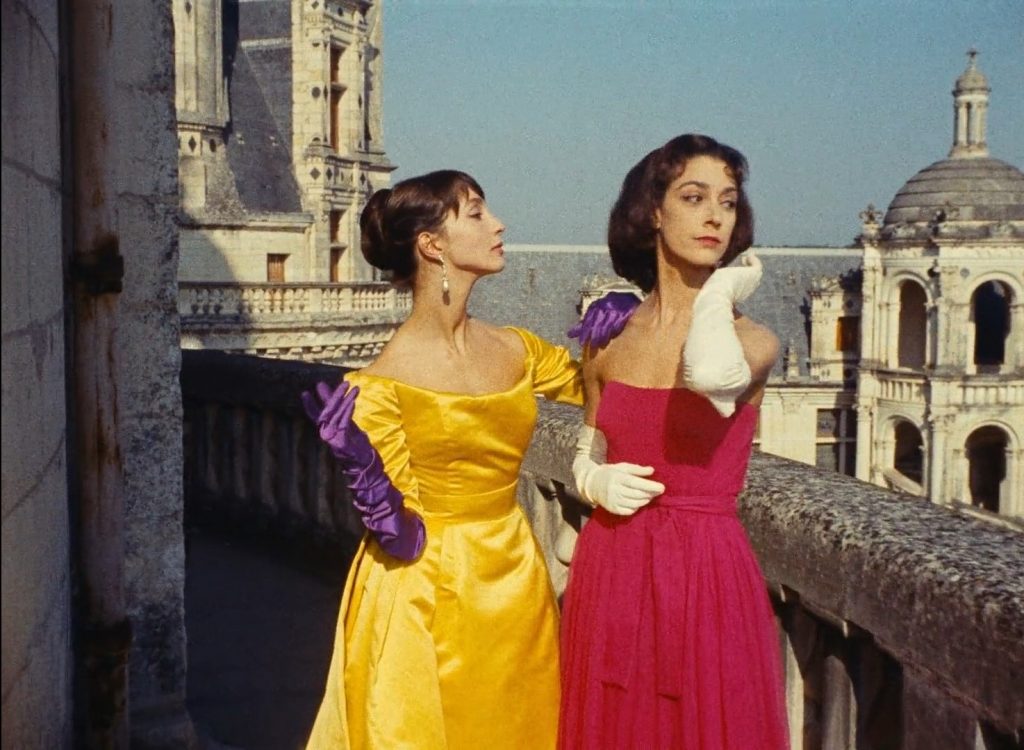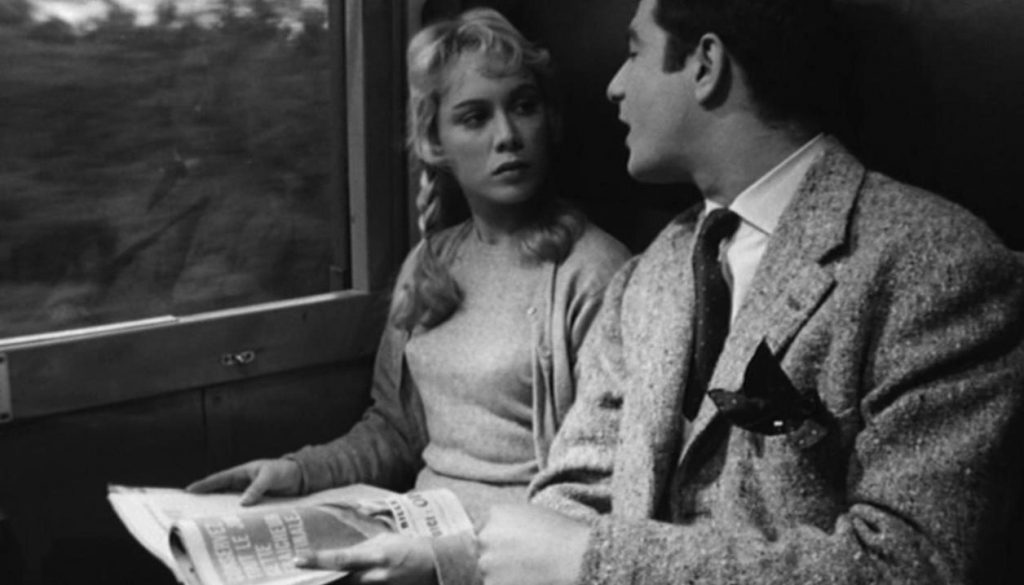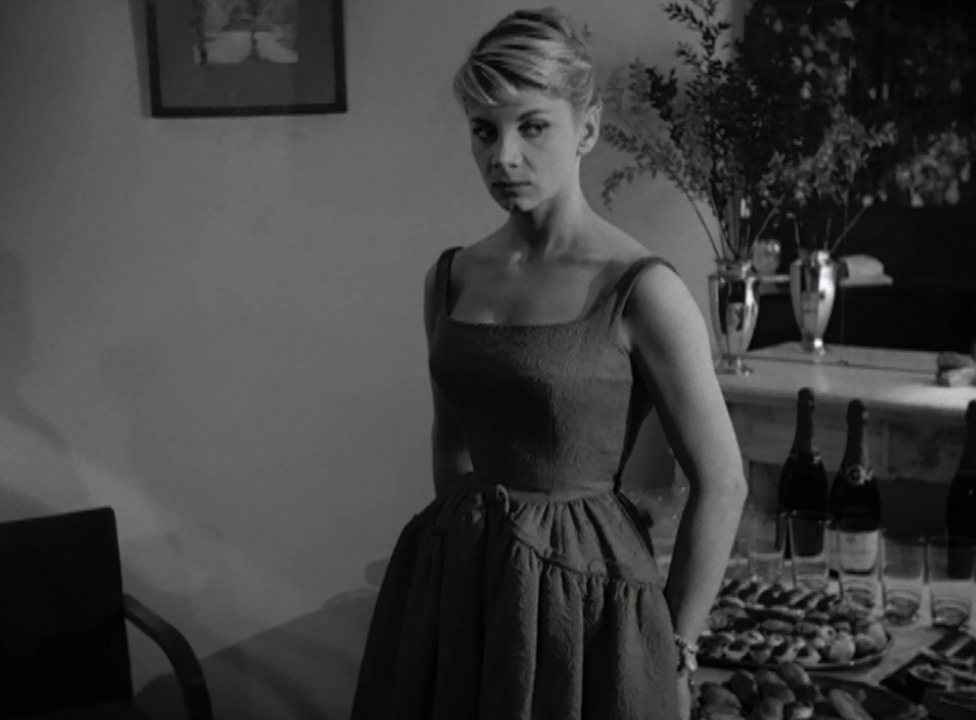The French New Wave in Short Form
By Michael Barrett
Not solely a movement in feature-length films, the French New Wave had plenty of short bite-size treats, including little-known filmmaker, Jeanne Barbillon, currently streaming on OVID.
The Botanical Avatar of Mademoiselle Flora (L’avatar botanique de Mlle Flora, 1965), written and directed by Jeanne Barbillon, is shot in sharp low-contrast black and white by New Wave master Raoul Coutard, scored by Michel Legrand and Jacques Loussier, and edited by Marguerite Renoir.
The playfulness and feminist themes rekindle Agnès Varda, yet Barbillon’s film has its own sensibility as it presents a woman’s point of view on existential ennui, presented in a self-conscious style, characteristic of the New Wave. The narrator is an enervated heroine, Flora (Bernadette Lafont), who does nothing much, feeling taken for granted by her soldier boyfriend (Louis Mésuret), whom she cheerfully calls ugly. His profession can be seen as a comment on the fact that men were required to do military service.
We might suppose Flora’s being kept as a girlfriend in captivity instead of pursuing her own interests, but what prevents this from being a standard feminist lament on “the second sex” (to quote Simone de Beauvoir) or “the feminine mystique” (Betty Friedan), is that Flora is bored with the entire modern world. As per her name, she feels an affinity for, and prefers the company of, plants.
In a famous Greek myth, Daphne flees the advances of Apollo and gets “saved” by turning into a tree, courtesy of her father Zeus. Whether that’s a happy ending is up to you, but Barbillon invents her own myth. Flora isn’t fleeing from sexual activity, she’s dissatisfied by not getting enough, but rather from all the traps of modern life. As a result, what begins as a cheeky snapshot of the contemporary dilemma turns into a mysterious fable.
Lafont is a New Wave star who acted alongside Claude Chabrol, Francois Truffaut, Jacques Rivette, Nelly Kaplan, Philippe Garrel and Jean Eustache. At least some of that work, like Kaplan’s A Very Curious Girl (1969) and Garrel’s Le Révélateur (1968), isn’t easy to find.
1965 was a busy year for Barbillon. She wrote and directed two shorts, the other being something called L’affaire des poissons (“the affair of the fishes”) starring the same Louis Mésuret with Gisèle Braunberger, François Béranger, and narrator Amédée. She also acted with Amédée and Claude Brasseur in a short by Jacques Espagne, Le pauvre bougre et le bon génie, roughly translated as “the poor bugger and the good genie.” I’d like to see those.
Barbillon went to work as an assistant director on several TV series, according to IMDB, and her only other credit as writer-director is a 1984 TV film called Les malheurs de Malou (“the misfortunes of Malou”) starring Lafont.

Speaking of Agnès Varda, the struggling young filmmaker accepted a 1958 commission from the board of tourism to showcase medieval castles of the Loire Valley. Either the board didn’t reckon with Varda’s playful creativity or they depended on it, for the result is O Seasons! O Castles! (Ô saisons, ô châteaux), shot in vibrant Eastmancolor by Quinto Albicocco.
The short film opens with four gardeners indulging in choreographed staging to the tune of André Hodeir’s Jazz Group of Paris, so this travelogue is already hip. At various points amid the narration about the castles, we’ll see or hear various workers whose job is to maintain the house or grounds. This choice, as opposed to interviewing rich people about living in a castle, or bureaucrats or historians about cultural legacy, clues us to Varda’s sympathies.
Acting as Varda’s avatar and narrator is veteran actress Danièle Delorme, who’d been in French film since the early ’40s. Such casting emphasizes that this film is from a woman’s perspective as Delorme tells us bits of history and gossip about the inhabitants of the castles.
A male voice, Antoine Bourseiller, recites poetry by famous men who stayed in or near the castles, such as Francois Villon. The film’s title is from a poem by Arthur Rimbaud. Some behind the scenes gossip: 1958 happens to be the birth year of Rosalie Varda, daughter of Varda and Bourseiller. I don’t know if this knowledge casts a new light on our appreciation of the film, but we can say with certainty that Varda brings a light touch to blocks of stone as she manages to blend the highbrow elements with “the people.”

While Varda was working for the tourist board, Jacques Doniol-Valcroze took a commission from the departments of Social Security and Health Education. The result is The Overworked (Les surmenés, 1958), a warning about taxing your strength with too much outside activity until you become less capable workers. No less than François Truffaut has the top writing credit, and Georges Delerue provides the jaunty music.
Before the credits, the film opens with five minutes of historical lecture and stock footage, spoken by Monique Chaumette, setting forth the thesis that humans used to be in tune with the sun and the seasons for a harmonious balance of work and leisure. I’m not sure when this paradise occurred, since most civilizations were taken up with conquest and slavery, but we’re told that automated life makes us distracted, frazzled and overworked, where forms of leisure cost money: “The pace of modern life is accelerating. Having thus broken with the mode of existence to which his atavism had prepared him, mankind is running out of steam, and overwork has become the disease of the century.”
Now that we’re in a proper panic, we then enter the story of 20-year-old Catherine (Yane Barry), a restless blonde from the country who has just won a typing contest and is coming to live in Paris with her sister and brother-in-law, the latter of whom is about to collapse from only getting four hours of sleep. He has a night job at a printer’s and then gets up early to go jogging, which seems unnecessary.
Catherine gets a typing job in the same company as her sister. More significantly, Catherine is already engaged to marry her boss Bernard (iconic star Jean-Pierre Cassel), which is established even before she goes to the bother of working with him (I guess it’s a French thing).
The road is rocky, however, for she meets fun-loving PR guy Jimmy (another major star, Jean-Claude Brialy). As with her overworked brother-in-law, Catherine will take to burning her candle at both ends by going dancing every night, until her typing starts to slip. We see proof of interracial dancing in late ’50s Paris, and it turns out that Cassel knows how to cut a snazzy rug.
An in-joke for New Wavers: A phone call from Mr. Chabrol, “the president,” causes the boss to jump. Claude Chabrol wasn’t only a burgeoning filmmaker but was producing many of his friends’ efforts.

The earliest film of the four is Jacques Rivette’s Fool’s Mate (Le Coup du Berger, 1956), a wry comedy starring both Doniol-Valcroze (acting as Etienne Loinod) and Brialy. As a bonus to make film buffs swoon, a party scene shows us Rivette, Chabrol, Truffaut and Jean-Luc Godard. If only Varda and Eric Rohmer had been there!
Virginie Vitry stars as Claire, whose dilemma is how to conceal her lover’s gift of an expensive fur coat from her bland husband. Chabrol co-wrote and co-produced the film, and the plot is a light variation on the kind of middle-class dramas of adultery in which he’d specialize as a director.
Some viewers may assume that Chabrol (a co-writer alongside Charles Bitsch and Rivette) was imitating his idol, Hitchcock, who directed an episode of Alfred Hitchcock Presents called “Mrs. Bixby and the Colonel’s Coat” in 1960, derived from a short story that appeared in 1959 by Roald Dahl, itself based on a popular old anecdote. In this instance, Rivette and Chabrol anticipate Hitchcock by four years.
Partly from his own love of Hitchcock, Rivette developed a style that used suspense devices to energize his preference for improvised narratives in his features. While his films might go in any direction, they’re often organized by a sense of mystery and suspense that seems to give them forward momentum. Fool’s Mate has a tighter scenario, but its combination of suspense with the shaggy-dog element propels his future style.
About the Author
Michael Barrett has written about film for decades, and for more than 20 years wrote a monthly video column in the San Antonio Express-News. National publications include Video Watchdog, Nostalgia Digest and a colorful piece in Retro Cinema on American No-Sex Comedies. To read more of his work, check him out at PopMatters.
